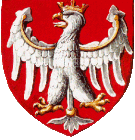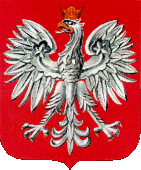

The Polish White Eagle
THE WHITE EAGLE - 700 YEARS OF THE COAT OF ARMS OF THE POLISH STATE
The Crowned White Eagle has been the Coat of Arms of the Polish State for seven centuries now. It is one of the oldest State Coats of Arms in the world. There are very few other countries who have managed to maintain their coats of arms for such a long period of time.
Several historic traditions and legends have referred to the origin of the White Eagle, moving it back to the times when the Polish State was being established, and even earlier. The Eagle was connected with Poland's first capital, Gniezno, where Lech, the legendary ancestor of the Piast dynasty was to find an eagle's nest (in Polish: "gniazdo"), and thus took the eagle as his coat of arms. On the other hand, Jan Dlugosz, Poland’s most distinguished chronicler living in the 15th century, wrote that Duke Boleslaw Chrobry was granted the Eagle as his coat of arms by the Emperor Otto III during the meeting of both Monarchs in Gniezno in the year 1000. The origin of the White Eagle is neither as fine nor as distant in time however. Generally, coats of arms did not exist before 12th century.
In Poland, the eagle appeared as a coat of arms for the first time on seals of several Dukes of the Piast dynasty (they were portrayed both standing and on horseback) in the years 1222-1236. It was their personal and family coat of arms and at the same time the emblem of their dukedoms. The eagle was selected as their coat of arms for its symbolic values. As the king of all birds it was a primeval symbol of power, victory, force and kingship. For the same reason, many monarchs in other countries, used the eagle in their coats of arms. The eagle of the Piast princes had different colors than the others. From the very beginning it was the White Eagle in the red shield (on "gules", according to heraldic terminology).
In the beginning, the eagle of Piasts had no crown. It was as late as when trends to unify Polish lands and to restore the Kingdom of Poland (disrupted as early as in the second half of the 11th century) emerged - when the Eagle's head was crowned. It took place in 1290, when the Duke of Great Poland and Kraków, Przemysl II put forward a plan to unite Poland, together with his own claim to the royal crown. When Przemysl II was crowned as the King of Poland in 1295, he introduced the White Eagle in a crown on the back side of his royal seal of majesty, as the Coat of Arms of the whole Kingdom of Poland. All Polish kings that followed accepted it in that character.
Beginning from the times of Wladyslaw Jagiello, that is from the end of 14th century, the Polish White Eagle was accompanied by "Pogon" (a knight on a horse with the raised sword in his hand), the coat of arms of Grand Duchy of Lithuania. It was a sign of the union of the two States under the rule of the same King.
The shape of the White Eagle changed following consecutive artistic styles in different times. The gothic Eagle of the Piasts and the Jagellons was followed in 16th century by a Renaissance one, then by a decorative baroque one, and finally by a harmonious and yet deprived of power of expression, classicistic 18th century one. At the beginning of 19th century the design of the Polish military eagle worn on soldiers’ caps developed. As the coat of arms of the Kingdom of Poland, the White Eagle was at the same time the personal Coat of Arms of each King. Beginning from 16th century, the connection between the Eagle and the King was expressed by his monogram on the Eagle's breast, later by his family coat of arms.
Despite the changing artistic form of the White Eagle, its ideological message was always the same. It was a symbol of the sovereign and independent Polish State, and of the King who personified all his subjects. As a symbol of the State and the King, it was present on royal seals and documents, on coins, army banners, on royal tombstones and residences, on State office buildings and more important churches; it was used during State and Court ceremonies. In 1705 King August II established the highest Polish decoration, the Order of the White Eagle, existing untill now.
In 1795, in the consequence of the partition of Poland by Russia, Prussia and Austria, and in the consequence of the breakdown of the State, the White Eagle lost its significance as the coat of arms an was replaced by the emblems of the foreign monarchies. It reappeared however, in every national uprising and in other attempts to restore independence (in 1831, 1846, 1848 and 1863/64). It became at that time the main visual symbol of the struggle for national independence. The left-oriented liberation movement took for their emblem the "democratic" White Eagle without the crown.
In 1918, when Poland regained freedom, the crowned White Eagle became once again the Coat of Arms of the Republic of Poland. Before the 2nd world war it had two officially accepted forms - the one from 1919 and the other from 1927 (the latter designed by Professor Zygmunt Kamiñski). Apart from the official designs, several stylistic forms of the White Eagle were in use at that time.
After the defeat in 1939 and during the German and Soviet occupation of the country the White Eagle, as Poland's coat of arms, was strictly forbidden. Once again it became the symbol of fight for free Poland. It was used by the underground army at home and by the regular Polish army abroad. The left-oriented armed forces, however, as well as the Polish army created in the Soviet Union, adopted the White Eagle without the crown. And such became the official Coat of Arms of Poland after 1945. Removing the crown from above the Eagle's head meant a change of the State's political system, from now on based on the principle of "people's democracy." That form of the White Eagle, though officially used till the end of 1989, was not commonly accepted by the Polish nation, so much attached to their previous, centuries-old national emblem.
And thus, when in consequence of the events of the 1980s, the political system in Poland was changed, it was possible again to restore the crowned White Eagle. On the 29th of December 1989, the Polish Sejm (Parliament) decided to bring back the White Eagle's crown. In 1990 its official design was defined, closely relating to that of 1927. In 1993 traditional emblems of the Polish Army were restored, among which was the Crowned White Eagle.
In 1995, the 700th anniversary of the White Eagle's coronation as the Coat of Arms of the Polish State was celebrated.


Go Back





